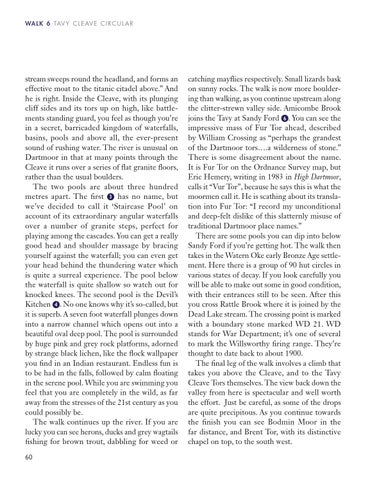Wa l k 6 Tav y Cl e av e Ci r cu lar
stream sweeps round the headland, and forms an effective moat to the titanic citadel above.” And he is right. Inside the Cleave, with its plunging cliff sides and its tors up on high, like battlements standing guard, you feel as though you’re in a secret, barricaded kingdom of waterfalls, basins, pools and above all, the ever-present sound of rushing water. The river is unusual on Dartmoor in that at many points through the Cleave it runs over a series of flat granite floors, rather than the usual boulders. The two pools are about three hundred metres apart. The first 3 has no name, but we’ve decided to call it ‘Staircase Pool’ on account of its extraordinary angular waterfalls over a number of granite steps, perfect for playing among the cascades. You can get a really good head and shoulder massage by bracing yourself against the waterfall; you can even get your head behind the thundering water which is quite a surreal experience. The pool below the waterfall is quite shallow so watch out for knocked knees. The second pool is the Devil’s Kitchen 4 . No one knows why it’s so-called, but it is superb. A seven foot waterfall plunges down into a narrow channel which opens out into a beautiful oval deep pool. The pool is surrounded by huge pink and grey rock platforms, adorned by strange black lichen, like the flock wallpaper you find in an Indian restaurant. Endless fun is to be had in the falls, followed by calm floating in the serene pool. While you are swimming you feel that you are completely in the wild, as far away from the stresses of the 21st century as you could possibly be. The walk continues up the river. If you are lucky you can see herons, ducks and grey wagtails fishing for brown trout, dabbling for weed or 60
catching mayflies respectively. Small lizards bask on sunny rocks. The walk is now more bouldering than walking, as you continue upstream along the clitter-strewn valley side. Amicombe Brook joins the Tavy at Sandy Ford 6 . You can see the impressive mass of Fur Tor ahead, described by William Crossing as “perhaps the grandest of the Dartmoor tors….a wilderness of stone.” There is some disagreement about the name. It is Fur Tor on the Ordnance Survey map, but Eric Hemery, writing in 1983 in High Dartmoor, calls it “Vur Tor”, because he says this is what the moormen call it. He is scathing about its translation into Fur Tor: “I record my unconditional and deep-felt dislike of this slatternly misuse of traditional Dartmoor place names.” There are some pools you can dip into below Sandy Ford if you’re getting hot. The walk then takes in the Watern Oke early Bronze Age settlement. Here there is a group of 90 hut circles in various states of decay. If you look carefully you will be able to make out some in good condition, with their entrances still to be seen. After this you cross Rattle Brook where it is joined by the Dead Lake stream. The crossing point is marked with a boundary stone marked WD 21. WD stands for War Department; it’s one of several to mark the Willsworthy firing range. They’re thought to date back to about 1900. The final leg of the walk involves a climb that takes you above the Cleave, and to the Tavy Cleave Tors themselves. The view back down the valley from here is spectacular and well worth the effort. Just be careful, as some of the drops are quite precipitous. As you continue towards the finish you can see Bodmin Moor in the far distance, and Brent Tor, with its distinctive chapel on top, to the south west.
